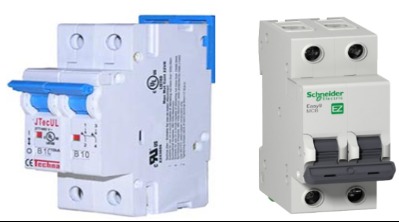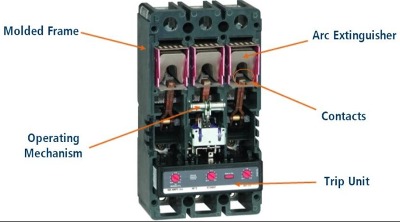
Most times, when there is a power surge or circuit overload, the circuit breaker trips to prevent electrical hazards.
Circuit breakers play some protective roles in our power system, ranging from circuit protection to shield from electric shock. It is a must-have device in our homes.
In this article, you will learn everything about electrical circuit breakers, types and functions in a power distribution.
What is a circuit breaker?
A circuit breaker is a switching device, designed to protect an electrical circuit from high voltage above normal.
It is a protective device used for switching different loads in buildings, industries, hotels and commercial complexes.
Circuit breaker and fuse are the same. The only difference is that you cannot reset the fuse or use it again after blowing.
Circuit breakers come in varying sizes, ranging from small devices that protect household appliances to large switchgear that protects high-voltage electric circuits.
Components of a circuit breaker.

Although we have different types of circuit breakers, some components are common in all. These include:
- Frame (breaker box): Protects the inner part of the breaker.
- Breaker contacts: Metallic materials that conduct currents when closed.
- Operating mechanism: Assist in the opening and closing of a breaker’s contact
- Arc extinguisher: Separates the arc when a breaker cuts off a faulty current
- Trip unit: Opens the operating system when there is a high-voltage or short circuit.
How a circuit breaker works
A circuit breaker comprises a fixed and moving contact or relay that opens and closes the circuit.
Under normal conditions, when the breaker is switched on, current flows through it to the entire system.
But once it detects excess current (faulty current), it cuts the power to protect the electrical system from damage. The heat generated from the over-current causes the moving contact of the breaker to open. This leads to a power failure.
Once the circuit breaker has shut off, it will require you to reset it before it will start working again.
But before that, try to find out why the breaker tripped. Some may be due to short circuits, overload, or even a bad breaker.
Related article: Why did my circuit breaker keeps tripping even with nothing plugged in
Qualities of a good circuit breaker
- It must be an excellent conductor of electricity when closed (switched on).
- It must also act as a good insulator while open.
- Their operations must be reliable
- Must be able to change from closed to open within the shortest time.
- Must not cause over voltage while switching
Functions of a circuit breaker
The functions of circuit breakers include:
- To protect wires and appliances from the effects of overload and short circuits
- To Isolate loads
- Protect human beings from electric shock.
- Allow shut down of power automatically and manually during maintenance.
Types of circuit breaker
There are various types of circuit breakers, they are classified according to their voltage level, interrupting type, construction type and structure.
Under voltage level, we have
- low-voltage circuit breakers,
- Medium voltage
- High-voltage circuit breakers.
Low-voltage circuit breakers
This breaker is rated for use at low voltage, between 0 and 1000V. They include:
Medium voltage circuit breakers
These breakers are rated for use on voltages from 1 to 72 kV (1000–72000 V). they include:
- Air circuit breaker: This breaker uses air as an extinguishing and interrupting medium.
- Vacuum circuit breaker: It uses vacuum as the arc breaking medium.
- Sulfur hexafluoride circuit breakers (sf6)
High-voltage breakers (72.5 kV and above)
High-voltage breakers can either be live or dead tanks. In a live tank, the interrupter chamber (tank) is raised above the ground by an insulator, at a high potential, while in dead tanks, the enclosure is on the earth’s metal.
High-voltage breakers are used in substations to protect the distribution system from earth faults and overload. They are classified according to the medium they used to extinguish the arc. These include:
- Air-blast circuit breaker
- Oil circuit breaker
- Bulk oil
- Carbon dioxide
- Minimum oil
- Sulfur hexafluoride.
Other circuit breakers
These include breakers that protect against ground faults that are too small to trip an over-current device. They include:
- Ground fault circuit interrupter (GFCI) or residual current device: A fast-acting receptacle that shuts off current once it senses leakage current. It is a shock protection device, mostly installed in the kitchen and bathrooms.
- Earth leakage circuit breaker (ELCB): This breaker detects current in the earth wire immediately rather than detecting imbalance.
- Arc-fault circuit interrupter: The breaker protects against loose connections. If it detects any, it trips to prevent electrical fires. The National Electrical Code recommends that every homeowner must have one.
Frequently Asked Questions
1. My circuit breaker tripped OFF. What could be wrong?
So many factors could be responsible. Some may be due to overload or short circuits.
If you experience such a power outage, check if they plug many appliances in the branch circuit and unplug them, if any. Or call an electrician for troubleshooting.
2. What are the importance of circuit breakers?
It helps protect your wires, appliances, and also regulates the effects of short circuits.
Prevent fire outbreaks that may arise from high voltage supply.
3. Are all circuit breakers the same?
Although they serve the same purpose, they are never the same. Several types of breakers exist, and the common ones include:
- Domestic circuit breakers: This is the type we use in our home to protect our wires and appliances.
- GFCI or (Residual Current Device (RCD): This breaker shuts off the light when it senses an imbalance between the incoming and the outgoing light. They prevent shocks which may arise from ground faults when currents contact water.
- Commercial circuit breakers: we use them on high-voltage circuits.
4. Fuse vs circuit breakers, any difference?
Fuse and breakers serve the same purpose, which is to open the circuit when there is a faulty current. However, they serve in unique ways.
While the breakers have an internal switch that goes off on exposure to overheat, the fuse has a metal that melts and, once it blows, it will be replaced, unlike the breakers.
What is circuit overload?
This is when you try to use more electricity than what your circuit is rated for. This causes the breaker to cut off the flow of electricity.
What is an AFCI Circuit Breaker?
AFCI is an arc-fault detection device that cuts off the flow of power once it detects an electric arc. The major cause of this fault is a loose connection in home electrical wiring.
What size breaker do I need for a dryer?
The normal size breaker for a dryer is a 30 amp double pole breaker, wired with a 10 gauge wire.
Take home
Circuit breakers are vital protective equipment that help safeguard our homes. When you install electricity in your homes, endeavor to add breakers too.
They act as a watchdog for the circuit and our electrical appliances. Don’t be the type that uses electric current without breakers, as the risk may be high.
Related articles